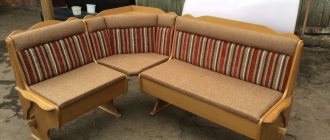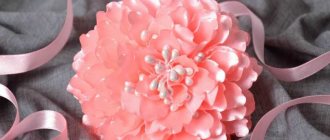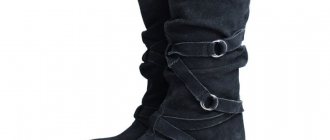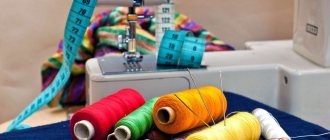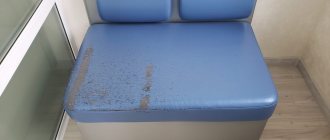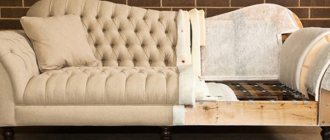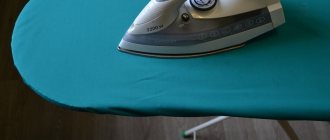When we choose fabric for upholstery in a bedroom, living room or children's room, we first of all pay attention to the color, texture and how its color will fit into the interior. But when it comes to choosing fabric for upholstering a kitchen corner, furniture fabric needs to be selected according to slightly different criteria. Because it is important to take into account that the kitchen is a room with high humidity and frequent temperature changes. The upholstery of kitchen furniture gets dirty more often and is more susceptible to dirt than in other rooms. What furniture fabric is ideal for upholstering a kitchen corner? Let's figure it out.
Advantages of self-upholstery
For a novice home craftsman, reupholstering kitchen corners is not difficult. Simple design, availability of materials, simple manipulations simplify the process. Advantages of independent work:
- saving money without losing quality;
- acquiring a new skill (after wear and tear, restoration will be needed again);
- You can carry out repairs at any time;
- the opportunity to choose the materials yourself.
Companies offer calling a specialist to your home, taking measurements or removing furniture for subsequent restoration. All this is not cheap, and it takes a lot of time. Therefore, independence is more appropriate here.
A high-quality result cannot be achieved without disassembly, so you will have to spend time disassembling the structure and removing elements. This will allow you to change the coating without damaging other surfaces.
The owner independently assesses the condition of the structure. To strengthen it you will need fittings and suitable fasteners. To update the appearance of wooden panels, you will have to resort to using paint and varnish. To facilitate the process, tools and materials are prepared in advance.
Saving money without losing quality
Learning a new skill
You can make repairs at any time
Possibility to choose your own materials
Selection of fabric for reupholstering the kitchen corner
Replacing upholstery material with another should be done without haste. It is recommended to choose the fabric and filling in advance; there should be no problems with choosing upholstery. Non-staining, wear-resistant materials are more suitable for the kitchen. Using leatherette will help create an expensive design.
Properly executed reupholstery of the kitchen corner will avoid the purchase of new furniture and save the family budget.
Suitable types of fabric for upholstering a kitchen corner:
- tapestry - characterized by density, wear resistance, the material retains its original appearance for a long time, a variety of tones and colors allow you to choose an option for any interior;
- velor - the main advantage is considered strength, fabric with dense pile looks stylish, over time the pile can wear out, as a result the upholstery does not look very presentable;
- flock - a dense material that is wear-resistant, waterproof impregnation simplifies the maintenance procedure;
- jacquard - looks stylish, but is not suitable for the kitchen due to rapid wear;
- PU leather - its characteristics resemble natural leather, it is wear-resistant, heat-resistant, elastic, ideal for upholstering kitchen furniture;
- eco-leather - polyurethane base provides such characteristics as elasticity, safety, hypoallergenicity, softness;
- PVC leather is considered the most popular material due to its affordable cost, the fabric is elastic, easy to care for, the only drawback is the release of harmful fumes into the atmosphere.
If necessary, you can also choose genuine leather for upholstery; regular care will help keep the material in good condition for many years.
Any material can be used to reupholster a kitchen corner.
Important! Furniture with genuine leather upholstery should not be placed near heat sources, this will help prevent its premature wear. When cleaning, it is recommended to use special detergents; they should not damage the integrity of the coating.
Selection of materials
Restoration of kitchen corners requires a careful approach to the choice of material, taking into account operating conditions. Coloring, unusual texture, original design of the canvas are less important than wear resistance and quality. The material is chosen so that you don’t have to reupholster it every year, and the appearance is preserved as long as possible.
| Type of material | Description | pros | Minuses |
| Leather | It is better not to choose genuine leather for self-repair. There is a risk of spoiling the material. It is worth giving preference to artificial. | Durability, spectacular appearance. Wide range of colors, shades, ease of care. | Even artificial leather can be faked, and such material has a much shorter service life. |
| Tapestry | Ideal for frequent use. | Relatively inexpensive material, long service life. Easy to care for using soap solutions. | It becomes unusable after greasy stains appear. Fades with prolonged exposure to direct sunlight. |
| Chenille | Popular material for restoration. | Democratic price. Pleasant to the touch surface. This upholstery is tear-resistant, does not fade, and does not absorb odors. | A wide range is presented only in large cities. In small ones the choice is limited. |
| Flock | Non-absorbent fabric. Suitable for those who decided to upholster furniture themselves for the first time. | The material is resistant to fading and stains. | Short service life: the textured pattern quickly peels off from the surface. |
When choosing material for upholstery, preference should be given to non-marking colors. High-quality fabric is easy to clean; a budget option is more difficult to get rid of stains. It is better to take measurements based on the dimensions of the removed upholstery. If the kitchen is made in the same style, then the material must match in color and texture. The use of contrasting shades for backs and seats is popular. In this case, the corner will become a fashionable accent in the kitchen.
The upholstery of kitchen corners suffers from frequent use, and the fillings lose their elasticity. Sheets of foam rubber are placed inside. In order not to make a mistake with the size, add a centimeter to the measurements on each side.
Leather
Tapestry
Chenille
Flock
Foam rubber
Upholstery requirements
The upholstery fabric must be durable. This requirement is universal. But this is very important for kitchen furniture, since nowhere else in the apartment are there so many sharp objects.
Choose a material that does not require special care. For example, suede and velor look chic. But what happens to their coating after regular contact with water? But accidental contamination in the kitchen is not uncommon. And they will have to be cleaned constantly.
So the fabric should be easy to care for and waterproof. So that if something happens, you can easily wipe the stain away. It’s good if the material has dirt-repellent properties, then removing greasy marks will take a minimum of time.
As for colors, the choice depends on the preferences of the owners and the interior. In pursuit of beauty, do not forget that dirt will be very noticeable on light surfaces. Therefore, preference should be given to more practical shades and patterns. For example, patterned.
Required Tools
The master will need the following tools:
- hammer;
- drill-driver;
- mites;
- spanners;
- stationery knife;
- glue;
- stapler;
- anti-stapler;
- scissors;
- marking tool.
All of the above is a minimum set. If the design is too complex, then additional tools will be needed. The consumables used are staples, glue, chalk, and furniture nails. If the condition of the furniture is completely deplorable, then you will need suitable fasteners, a jigsaw, sandpaper, and a pry bar. A screwdriver and wrenches will help you disassemble the structure. An anti-stapler and a knife are useful for removing upholstery.
The filler is not always easy to remove. If the manufacturer glued foam rubber, you will have to remove it with a knife and then clean the surface. High-quality glue will allow you to glue the upholstery (a special one is used), and a stapler will allow you to secure the fabric (furniture nails will also work). A knife is recommended for cutting material, and scissors and chalk are recommended for cutting.
What is furniture reupholstery?
Reupholstery is the replacement of upholstery and lining materials. Often, high-quality work results cannot be achieved without disassembling the furniture. The upholstery of many kitchen corners can only be updated by disassembling the structure into individual elements. It is easier to remove the old coating from them without causing damage to other parts. In most cases, repairing a kitchen corner is not limited to reupholstery, since you have to strengthen the frame of the sofa, cover it with varnish or paint, change fasteners, accessories, etc.
Stages of work
Do-it-yourself reupholstery of a kitchen corner consists of the following steps:
- design analysis;
- removing old upholstery;
- removing the filler;
- taking measurements and developing patterns;
- sewing cushion covers;
- strengthening the new filler;
- securing new upholstery;
- decoration.
If the condition of the corner is unsatisfactory, then the replacement of drawers, panels and restoration of wooden parts will be added to the stages of work. Additionally, you may need to purchase and install new fittings and strengthen structural elements (if they are loose). Poor quality material wears out more over time, creating an additional problem - repairing weak bolts. Broken sockets are expanded with a drill, dowels are inserted (they are pre-coated with PVA). After the glue has completely dried, you can continue assembling the structure. Self-tapping screws must be used for fastening.
Removing the upholstery
Step-by-step instructions will help you reupholster your kitchen corner properly. An anti-stapler will get rid of staples. It is better not to use a knife for such a procedure, otherwise fasteners may remain in the wooden panel. To remove them, you will need pliers or pliers.
The upholstery is followed by removing the filling. Manufacturers often glue foam rubber to the base. A sharp knife will help to gradually scrape the surface, which must then be carefully removed. The remaining parts of the foam are also removed.
The entire process of removing upholstery, in the case where the design is the same as a non-separable sofa and the corner is completely covered with fabric, comes down to the following points:
- removing seats by removing hinged fasteners;
- backrest disassembly;
- separation of the box from the legs;
- checking parts for fastening and fittings;
- removing staples with an anti-stapler;
- getting rid of filler.
Removing the seats
Parsing the back
Separating the box from the legs
Checking fastening parts and fittings
Removing staples with an anti-stapler
Getting rid of filler
The process of removing the upholstery when the kitchen corner looks like a simple bench with a soft seat and back is divided into several stages:
- clear free space around;
- the frame is dismantled;
- the fabric is removed with an anti-stapler;
- check the corner itself for integrity;
- restore worn parts;
- remove old foam rubber;
- cut new foam rubber and glue it;
- the covers are pulled over the frame;
- fixed with staples on the reverse side without distortion;
- assemble the product.
The removed fabric will be used to clarify measurements, so its integrity must be preserved. Damaged or torn material will not allow you to determine the exact dimensions; for this reason, the structure itself is measured with an allowance for bending.
Disassemble the frame
Remove the upholstery
Restore worn parts
Replace old foam
Cover all parts with fabric
Assemble the product
Cutting fabric and filling
How to renew a kitchen corner after disassembling and removing the upholstery - more on this below. It will not be possible to achieve a high-quality result if you do not cut the fabric or cut the stuffing in advance. Previously removed material is used as a pattern. It is desirable that each element is sheathed in one piece. If this is not possible, then you will need to fasten the flaps together before laying out and tracing the pattern.
If the new upholstery is much denser than the old one, you need to add a couple of centimeters to the measurements. A flap that is too small will not allow enough tension in the fabric. As a result, the material will be damaged, and you will have to take measurements and cut it again.
The master must leave allowances that will be used for tucking and fastening. It is easier to work with the filler; it is simply cut along the contour of the piece of wood or plywood to which it will be glued. To keep the shape longer, add one centimeter to each side when cutting the filler. When fastening, you can use glue or staples (fixation in increments of up to 100 mm).
Cut fabric using old material
Trim the filler along the contour of the furniture
Frame repair
The design of most furniture quickly deteriorates. Before you reupholster the kitchen corner with your own hands, you need to inspect all the elements for wear. Accurate markings and careful, careful work without haste will help you avoid problems during subsequent assembly. One of the common problems is peeling coating on the legs.
Restoration of wooden parts takes place in several stages:
- cleansing from dirt and stains;
- removal of remaining coating;
- sanding;
- filling cracks and delaminations with glue;
- painting;
- fixing the result with varnish.
Any wooden element may require restoration, but a primer is needed before using varnish or paint. In the case when parts of the furniture are replaced with new ones, it is necessary to mark and drill holes in advance for subsequent fastening. Frame repair is a common need when reupholstering a kitchen corner. Elements that have fallen into disrepair are restored. If the wooden legs have lost their former luster or the coating has peeled off, then they are cleaned of external contaminants, sanded, varnished or painted. If cracks or gaps appear in the frame, they are filled with wood glue.
In case of significant damage, the part can be replaced entirely by cutting it out of chipboard. Accuracy and precise markings will make it easier to assemble furniture with a new element. In this case:
- legs are renewed;
- cracked plywood sheets are replaced;
- cracks and delaminations are filled with glue;
- Scratched boards are sanded.
To reliably glue the parts of the structure together, experts advise using clamps. They will press down on glue-coated surfaces without having to hold them with your hands. Clamps enhance the adhesive properties of the material and allow you to securely fasten parts.
Clean from dirt and stains
Remove remaining coating
Sand
Fill cracks and delaminations with glue
Paint and varnish
Reupholstery and assembly
Re-upholstery and assembly are carried out step by step:
- Attach the filler with glue or staples. The standard step is from 5 to 10 centimeters. You will often have to install fasteners on curved surfaces.
- The cut fabric is placed face down on the floor. The part is placed on top of it.
- On each side the material is fixed in the center. Gently tighten so that no distortion occurs.
- Fix in increments of 3 to 4 centimeters using staples.
If the design is complex or the padding is too thin, then we tighten the surface with a carriage tie. Furniture nails can be used as fasteners. This will increase the service life of the new coating.
Reassemble the kitchen corner in the reverse order of disassembly. Where the fasteners will subsequently be, all holes are drilled in advance. This will help avoid damage to the upholstery and filling. The duration and complexity of the work depend on the design. For example, when assembling a sofa from three components, the sequence of actions does not change, only the corner part is assembled first, and then the side parts.
Attach filler
Cover with fabric
Assemble the corner
What material is best for a kitchen sofa?
Reupholstering furniture is a great way to update your interior.
Find out the cost
Quickly and conveniently send photos of furniture via messenger
Call a surveyor
By phone or through the form on the website. Departure is possible any day of the week, including weekends
Select material
According to catalogs and samples. Materials are available both in stock and on order.
We take it to the workshop
The old upholstery is removed. New covers are sewn over the old upholstery and stuffed back in
Delivery
We pack and deliver to you.
Your furniture is ready
Your upholstered furniture is new again!
Agreement
We conclude and sign an agreement
Guarantee
12 month guarantee on work performed
It's profitable with us
We deliver quality work within the agreed time frame
Find out the cost in one click
About Us
Our workshop specializes in fast and high-quality furniture reupholstery. We have our own workshop, and all repair processes are carried out using modern equipment. Furniture upholstery is sewn by professional seamstresses, using reliable upholstery materials from well-known imported and domestic manufacturers.
Time-tested reputation. We have been working in the services market since 2014. Our credo is quality and reliability. Our advantages are an individual approach to each client and perfect execution of the work, regardless of its complexity. Reupholstery of chairs, armchairs, sofas by specialists from our workshop is guaranteed to return the original appearance of the furniture
Exclusive upholstery of upholstered furniture. One of the company's activities is reupholstery of branded furniture. Reupholstering sofas with genuine leather, replacing transformation mechanisms, restoring the original shape. Contact us! Working with us is pleasant, convenient and profitable!
How to decorate
The updated kitchen corner can be left unchanged or decorated. Several popular decoration options:
- decoupage;
- pillows with contrasting covers;
- adding bright accents in the form of rollers or blankets;
- decoration with inserts made of genuine leather or suede;
- use of knitted capes;
- hand painted;
- fastening plywood ornaments.
For decoration, stencils are used that will help you apply designs of varying degrees of complexity onto wooden panels. The use of fringe or tassels is no longer relevant. A repeating pattern is applied to the arms, legs and small plain elements.
You should not use more than two ways to decorate a kitchen set. Too much decoration will ruin the appearance of the corner. It is better to opt for a more concise option.
The decoupage technique should be used with caution. For decoration, one color scheme and one type of pattern are used. If the kitchen already has furniture or appliances decorated in the same way, then it is better to abandon this idea. Otherwise, the appearance will be rustic and rustic.
Even a novice craftsman can reupholster a kitchen corner. The main thing is to strictly follow the step-by-step instructions, do the work carefully and without haste. Updated furniture will decorate the kitchen.
What is the best way to cover a sofa?
Below we will look at several options for fabric that can be used for upholstery.
- Jacquard A beautiful material with an impressive relief texture and high density. ...
- Tapestry...
- Leather...
- Arpatek…
- Scotchgard...
- Flock...
- Chenille...
- Forest
Interesting materials:
Where to get a patent in the Moscow region? Where can I get a Western Union Krasnodar transfer? Where can I get a gift in World of Tanks? Where to get a health insurance policy in Krasnodar? Where can a child get a policy? Where can I receive an IML parcel? Where can I get a registration ticket? Where can I get a certificate of additional education? Where can I get an ent certificate? Where can I get a personal income tax certificate 2 for an unemployed person?
How to sew a cover yourself
To protect the upholstery, you can use a corner cover. First you need to choose the shape of the cover and fabric. Draw it yourself or find the appropriate pattern on the Internet. Take some old fabric, cut it according to the patterns and sew it.
You can use leather or fabric upholstery on the sofa.
Try the resulting draft on your corner. If any defects are found, correct them. If you are satisfied with how the trial version fits on the corner, then proceed to cutting out the main material. Sew in zippers and clasps if necessary. Decorate the case as you wish.
Choose the color of the fabric based on the interior design of the kitchen.
Place the finished cover on your kitchen corner. But don’t get carried away with decorating too much, because this is a cover designed for a kitchen corner, and an abundance of decorative elements will look inappropriate there.
The leather upholstered corner is easy to use and care for.
